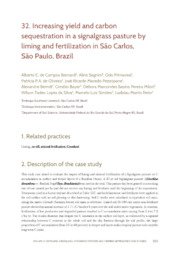Increasing yield and carbon sequestration in a signalgrass pasture by liming and fertilization in São Carlos, São Paulo, Brazil.
Increasing yield and carbon sequestration in a signalgrass pasture by liming and fertilization in São Carlos, São Paulo, Brazil.
Author(s): BERNARDI, A. C. de C.; SEGNINI, A.; PRIMAVESI, O. M. A. S. P. R.; OLIVEIRA, P. P. A.; PEZZOPANE, J. R. M.; BERNDT, A.; BAYER, C.; MILORI, D. M. B. P.; SILVA, W. T. L. da; SIMOES, M. L.; MARTIN NETO, L.
Summary: This study case aimed to evaluate the impact of liming and mineral fertilization of a Signalgrass pasture on C accumulation in surface and deeper layers of a Brazilian Oxisol. A 27-yr old Signalgrass pasture ((Urochloa decumbens cv. Basilisk Stapf (Syn: Brachiaria)) was used in the trial. This pasture has been grazed in a stocking rate of one animal per ha and did not receive any liming and fertilizer until the beginning of the experiment. Treatments used in a 6-year trial are described in Table 129, and both limestone and fertilizers were applied to the soil surface with no soil plowing or disc-harrowing. Soil C stocks were calculated in equivalent soil mass, taking the native Cerrado (Savanna forest) soil mass as reference. Limed soil (0-100 cm) under non-fertilized pasture showed an annual increase of 1.71 tC/ha after 6 years over the soil under native vegetation. In contrast, fertilization of low productive and degraded pasture resulted in C accumulation rates varying from 5.4 to 7.2 t/ha/yr. The results illustrate that despite the C saturation in the surface soil layer, as evidenced by a sigmoid relationship between C contents in the whole soil and the clay fraction through the soil profile, the large proportion of C accumulation (from 55 to 68 percent) in deeper soil layers makes tropical pasture soils suitable long-term C sinks.
Publication year: 2021
Types of publication: Book sections
Observation
Some of Embrapa's publications are published as ePub files. To read them, use or download one of the following free software options to your computer or mobile device. Android: Google Play Books; IOS: iBooks; Windows and Linux: Calibre.
Access other publications
Access the Agricultural Research Database (BDPA) to consult Embrapa's full library collection and records.
Visit Embrapa Bookstore to purchase books and other publications sold by Embrapa.

